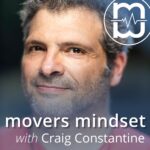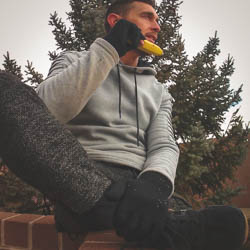
How can Parkour principles be adapted to improve the health, mobility, and confidence of seniors?
Sean Hannah takes us deep into curriculum development; how he researches, the importance of games and fun, and developing with specific audiences in mind. He discusses his role in designing the curriculum for the PK Move Study with Marymount University, and the specific challenges it presented. Sean shares advice on coaching and designing for adults and seniors, before unpacking his current personal curriculum and goals.
“We’re going to spend a lot of time on the Single Point. …and for all the Mine Craft kids listening out there, my Fortnight players who want to do Parkour… Single Point is still your best training tool. It’s seriously overlooked in the [parkour] community because it’s hard to make money selling ninja stuff, where you’re just standing on one foot for a while.” ~ Sean Hannah (20:50)
The conversation explores how Parkour can be adapted to address the unique physical and psychological challenges seniors face, focusing on fall prevention and improving overall mobility. It highlights the development of PK Silver, a Parkour program designed for older adults, and details the thought process behind designing a curriculum that makes movement both accessible and enjoyable for this age group. Games and creative scenarios are used to build strength and confidence in seniors, ultimately improving their quality of life.
The discussion also covers a study conducted with Marymount University, which examined the effectiveness of Parkour-based training for seniors. Emphasis is placed on low-impact, balance-focused exercises that encourage participants to overcome fear and improve their autonomy. The curriculum emphasizes simple but essential movements, such as getting up from the ground or navigating stairs, reimagined through the lens of Parkour. The success of the program demonstrates that the core tenets of Parkour—play, exploration, and adaptability—can have significant benefits for populations traditionally excluded from high-intensity physical disciplines.
Takeaways
Applying Parkour to seniors — Parkour can be adapted to improve balance, mobility, and confidence in seniors by focusing on simple, practical movements.
Fall prevention — Parkour’s focus on controlled landings and body awareness directly addresses the leading cause of injury and death among seniors.
Curriculum development — Designing a curriculum for seniors requires rethinking basic movement patterns, emphasizing balance, and starting from simple, low-risk activities.
Perception and fear — One of the biggest obstacles in teaching Parkour to seniors is overcoming the fear and perception that Parkour is dangerous or exclusive to younger people.
Fun and games — Reframing daily tasks as games or challenges can make movement enjoyable, reducing fear and increasing engagement.
Physical autonomy — The program emphasizes movements that directly improve seniors’ ability to navigate their environment, preserving independence and reducing fall risk.
Movement at all ages — Parkour principles apply universally, from children to seniors, reinforcing that movement exploration is valuable throughout life.
Importance of walking — Simple skills like walking are often overlooked but are essential for mobility and can be developed through Parkour-based practices.
Parkour for middle-aged adults — Programs like 401 PK show that Parkour can also address the needs of adults over 35, focusing on sustainable and low-impact movement.
Resources
PK Move — Nonprofit organization focused on bringing Parkour to seniors and special populations.
Marymount University — Partnered with PK Move to conduct a study on the effectiveness of Parkour for seniors.
Art of Retreat — An event where the PK Silver program was presented to the Parkour community.
Urban Evolution — Gym where curriculum for adults over 35 (401 PK) was developed and implemented.
American College of Sports Medicine — Hosting the presentation of the Marymount University study on Parkour for seniors.
(Written with help from Chat-GPT.)
— Hello👋 I’m Craig Constantine.
In the Movers Mindset podcast, I talk with movement enthusiasts to learn who they are, what they do, and why they do it. I’m interested in the nature and philosophy of movement and in exploring themes like independence, self-direction, and human excellence. My interests color each conversation and provide some structure to Movers Mindset. But since I like to take the scenic route, every conversation ends up going somewhere unique.
The purpose of Movers Mindset is to create and share great conversations with movement enthusiasts. Each conversation feeds my insatiable curiosity, but I share them to turn on a light for someone else, to inspire them, or to give them their next question.
I appreciate your time and attention, and I don’t take it for granted.
— Thank you!
Want more? Subscribe to the email list for weekly updates—new episodes and archive highlights delivered to your inbox.
I invite you to cultivate a meaningful life—through presence, not pursuit. You can learn more about me and all my projects at, https://craigconstantine.com.
If you like what I’m doing through Movers Mindset, learn more about becoming a patron.
ɕ
